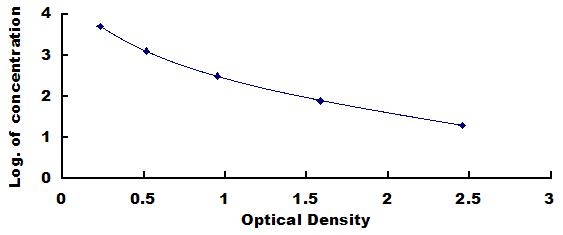Packages (Simulation)

Reagent Preparation

Image (I)
Image (II)
Certificate


ELISA Kit for Gastric Inhibitory Polypeptide (GIP)
Incretin hormone; Glucose Dependent Insulinotropic Peptide
- Product No.CEA882Ge
- Organism SpeciesPan-species (General) Same name, Different species.
- Sample Typeserum, plasma, tissue homogenates, cell lysates, cell culture supernates and other biological fluids
- Test MethodCompetitive Inhibition
- Assay Length2h
- Detection Range19.5-5,000pg/mL
- SensitivityThe minimum detectable dose of this kit is typically less than 6.9pg/mL.
- DownloadInstruction Manual
- UOM 48T96T 96T*5 96T*10 96T*100
- FOB
US$ 485
US$ 693
US$ 3119
US$ 5891
US$ 48510
For more details, please contact local distributors!
Specificity
This assay has high sensitivity and excellent specificity for detection of Gastric Inhibitory Polypeptide (GIP).
No significant cross-reactivity or interference between Gastric Inhibitory Polypeptide (GIP) and analogues was observed.
Recovery
Matrices listed below were spiked with certain level of recombinant Gastric Inhibitory Polypeptide (GIP) and the recovery rates were calculated by comparing the measured value to the expected amount of Gastric Inhibitory Polypeptide (GIP) in samples.
| Matrix | Recovery range (%) | Average(%) |
| serum(n=5) | 93-105 | 98 |
| EDTA plasma(n=5) | 98-105 | 101 |
| heparin plasma(n=5) | 88-95 | 91 |
Precision
Intra-assay Precision (Precision within an assay): 3 samples with low, middle and high level Gastric Inhibitory Polypeptide (GIP) were tested 20 times on one plate, respectively.
Inter-assay Precision (Precision between assays): 3 samples with low, middle and high level Gastric Inhibitory Polypeptide (GIP) were tested on 3 different plates, 8 replicates in each plate.
CV(%) = SD/meanX100
Intra-Assay: CV<10%
Inter-Assay: CV<12%
Linearity
The linearity of the kit was assayed by testing samples spiked with appropriate concentration of Gastric Inhibitory Polypeptide (GIP) and their serial dilutions. The results were demonstrated by the percentage of calculated concentration to the expected.
| Sample | 1:2 | 1:4 | 1:8 | 1:16 |
| serum(n=5) | 96-104% | 97-105% | 82-95% | 79-89% |
| EDTA plasma(n=5) | 98-105% | 96-105% | 83-98% | 98-105% |
| heparin plasma(n=5) | 79-95% | 89-97% | 80-92% | 91-99% |
Stability
The stability of kit is determined by the loss rate of activity. The loss rate of this kit is less than 5% within the expiration date under appropriate storage condition.
To minimize extra influence on the performance, operation procedures and lab conditions, especially room temperature, air humidity, incubator temperature should be strictly controlled. It is also strongly suggested that the whole assay is performed by the same operator from the beginning to the end.
Reagents and materials provided
| Reagents | Quantity | Reagents | Quantity |
| Pre-coated, ready to use 96-well strip plate | 1 | Plate sealer for 96 wells | 4 |
| Standard | 2 | Standard Diluent | 1×20mL |
| Detection Reagent A | 1×120µL | Assay Diluent A | 1×12mL |
| Detection Reagent B | 1×120µL | Assay Diluent B | 1×12mL |
| TMB Substrate | 1×9mL | Stop Solution | 1×6mL |
| Wash Buffer (30 × concentrate) | 1×20mL | Instruction manual | 1 |
Assay procedure summary
1. Prepare all reagents, samples and standards;
2. Add 50µL standard or sample to each well.
And then add 50µL prepared Detection Reagent A immediately.
Shake and mix. Incubate 1 hour at 37°C;
3. Aspirate and wash 3 times;
4. Add 100µL prepared Detection Reagent B. Incubate 30 minutes at 37°C;
5. Aspirate and wash 5 times;
6. Add 90µL Substrate Solution. Incubate 10-20 minutes at 37°C;
7. Add 50µL Stop Solution. Read at 450 nm immediately.
GIVEAWAYS
INCREMENT SERVICES
| Magazine | Citations |
| Scientific Reports | The anti-hyperglycemic efficacy of a lipid-lowering drug Daming capsule and the underlyingsignaling mechanisms in a rat model of diabetes mellitus. pubmed:27721485 |
| Obesity surgery | The Effects of Duodenojejunal Omega Switch in Combination with High-Fat Diet and Control Diet on Incretins, Body Weight, and Glucose Tolerance in Sprague-Dawley Rats. pubmed:28840471 |
| Obesity Surgery | Preserving Duodenal-Jejunal (Foregut) Transit Does Not Impair Glucose Tolerance and Diabetes Remission Following Gastric Bypass in Type 2 Diabetes Sprague … Pubmed:29098544 |
| BioMed Research International | Predictors of Effectiveness of Glucagon-Like Peptide-1 Receptor Agonist Therapy in Patients with Type 2 Diabetes and Obesity |
| Diabetes Research and Clinical Practice | Low AS160 and high SGK basal phosphorylation associates with impaired incretin profile and type 2 diabetes in adipose tissue of obese patients Pubmed: 31734225 |
| OBESITY SURGERY | The Leading Role of Peptide Tyrosine Tyrosine in Glycemic Control After Roux-en-Y Gastric Bypass in Rats Pubmed: 31701411 |
| FUTURE SCIENCE | Prediction scale of response to liraglutide therapy as the method for increase of treatment efficacy in type 2 diabetes Pubmed:35251693 |
| Catalog No. | Related products for research use of Pan-species (General) Organism species | Applications (RESEARCH USE ONLY!) |
| PAA882Ge01 | Polyclonal Antibody to Gastric Inhibitory Polypeptide (GIP) | WB; IHC; ICC; IP. |
| MAA882Ge21 | Monoclonal Antibody to Gastric Inhibitory Polypeptide (GIP) | WB; IHC; ICC; IP. |
| MAA882Ge28 | Monoclonal Antibody to Gastric Inhibitory Polypeptide (GIP) | WB; IHC; ICC; IP. |
| CEA882Ge | ELISA Kit for Gastric Inhibitory Polypeptide (GIP) | Enzyme-linked immunosorbent assay for Antigen Detection. |















